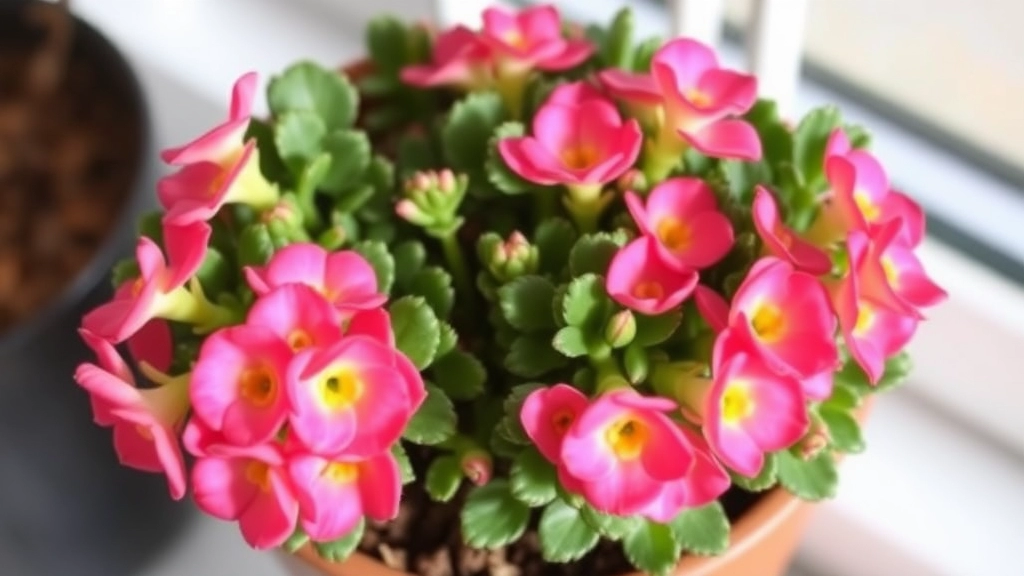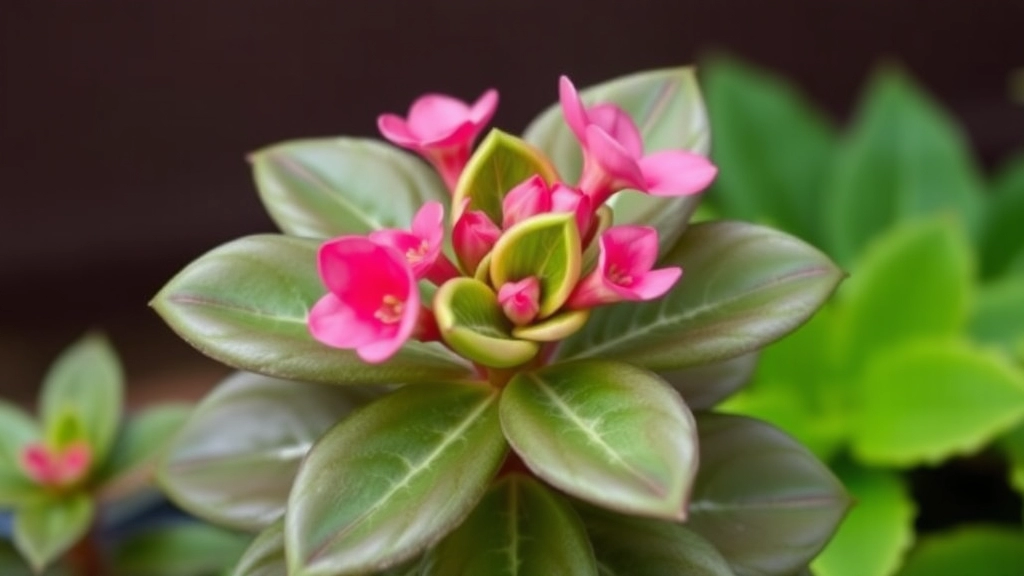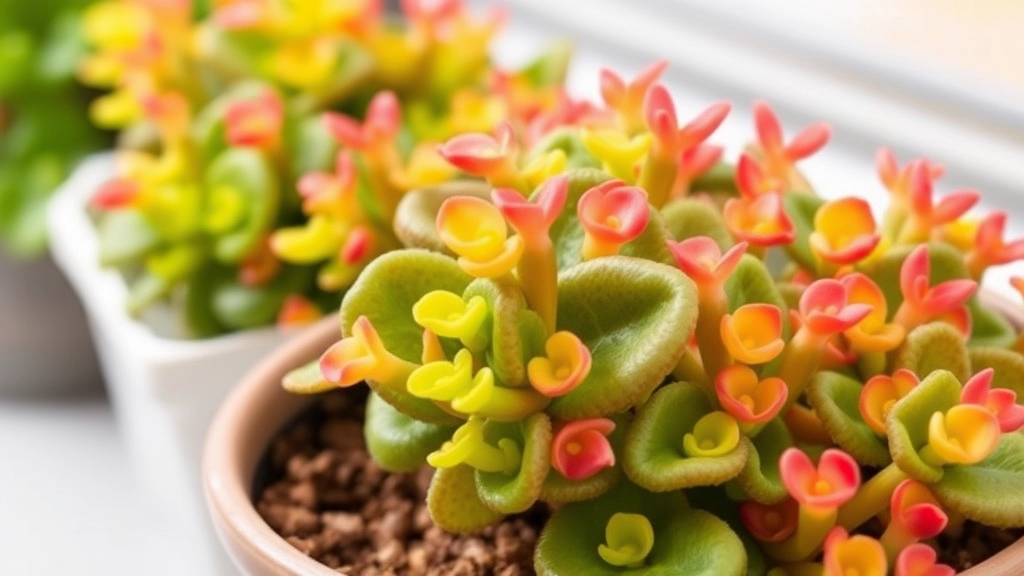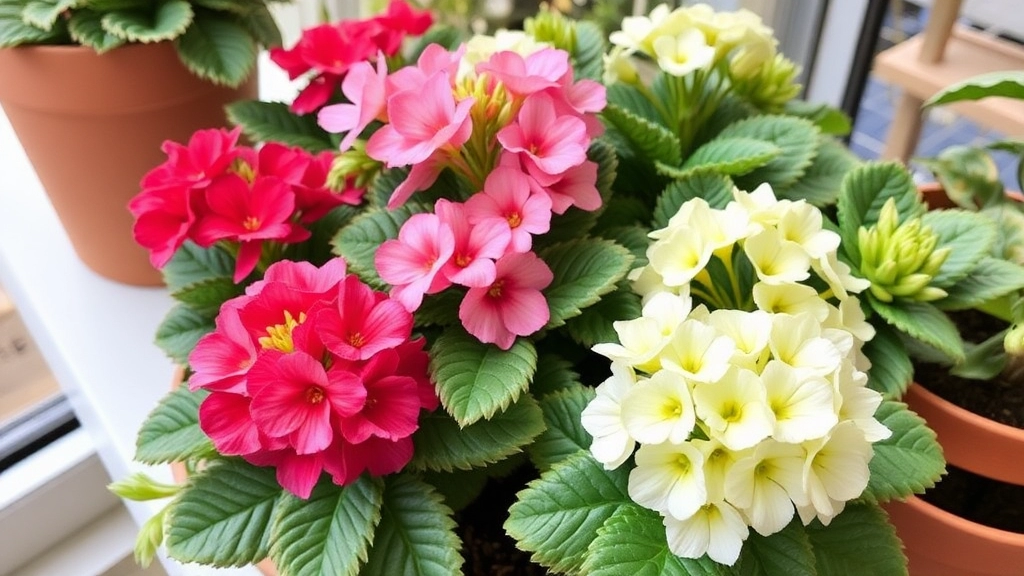Brighten Up Your Home with Stunning Indoor Kalanchoe Varieties
Are you looking to brighten up your home with some stunning indoor kalanchoe varieties? You’re in the right place! Kalanchoe plants are not only beautiful but also easy to care for, making them perfect for indoor gardening. Whether you want vibrant blooms, unique foliage, or compact plants for small spaces, there’s a kalanchoe variety that will suit your needs.
From popular flowering types to low-maintenance options for beginners, indoor kalanchoe varieties offer something for everyone. Discover which species thrive in low-light environments and learn how to care for them to keep your indoor garden looking fresh and lively. Ready to explore the best kalanchoe plants for your home? Let’s dive in!
Popular Indoor Kalanchoe Varieties
When considering indoor plants, many of us often wonder which varieties will thrive in our homes. Kalanchoes are a fantastic choice, offering vibrant blooms and unique foliage that can brighten any space.
Kalanchoe Blossfeldiana
- Known for its stunning clusters of flowers.
- Blooms in various colours, including red, pink, and yellow.
- Ideal for beginners due to its resilience.
Kalanchoe Tomentosa (Panda Plant)
- Features fuzzy, silvery-green leaves with brown edges.
- A unique appearance that adds character to any collection.
- Low maintenance and drought-tolerant.
Kalanchoe Luciae (Flapjacks)
- Recognised for its large, flat leaves that resemble pancakes.
- Changes colour with sunlight exposure, turning a beautiful red.
- Perfect for a sunny windowsill.
Kalanchoe Thyrsiflora
- Displays upright clusters of yellow flowers.
- Its thick, succulent leaves store water, making it drought-resistant.
- A striking addition to any indoor garden.
Kalanchoe Marmorata (Pencil Plant)
- Characterised by its mottled leaves, which have a unique pattern.
- Grows well in indirect light and requires minimal watering.
- An excellent choice for those looking to add visual interest.
These popular indoor Kalanchoe varieties not only enhance your indoor environment but also cater to various aesthetic preferences and care levels. For more detailed care tips, check out our Complete Care Guide for Kalanchoe Flapjack Plant and learn how to keep your Kalanchoe Panda Plant healthy.
Best Flowering Kalanchoe Types for Indoors

So, you’re looking to brighten up your indoor space with some vibrant blooms?
Kalanchoes are a fantastic choice, bursting with colour and personality.
Here are some of the best flowering Kalanchoe types you can bring indoors:
1. Kalanchoe Blossfeldiana
- Why It’s Great: Known for its showy clusters of tiny flowers, this variety comes in a rainbow of colours, from bright pinks to yellows.
- Care Tips: It loves bright, indirect sunlight and needs watering only when the soil is dry.
2. Kalanchoe Luciae (Paddle Plant)
- Why It’s Great: This one’s not just about flowers; its unique, paddle-shaped leaves often turn a stunning red when exposed to sunlight.
- Care Tips: Keep it in a sunny spot and let the soil dry out between waterings.
3. Kalanchoe Thyrsiflora (Flapjack)
- Why It’s Great: With its large, flat leaves and yellow flowers, it’s a real eye-catcher.
- Care Tips: Similar to the Paddle Plant, it thrives in bright light and prefers dry conditions.
4. Kalanchoe Marmorata (Pencil Plant)
- Why It’s Great: This variety features striking marbled leaves and produces lovely clusters of pink flowers.
- Care Tips: It enjoys bright light but can tolerate some shade. Water sparingly.
5. Kalanchoe Beharensis (Chandelier Plant)
- Why It’s Great: Known for its unique, large leaves and tall flower spikes, it’s a showstopper in any room.
- Care Tips: Prefers bright light and needs little water, making it a low-maintenance option.
Quick Care Checklist
- Light: Bright, indirect sunlight is key.
- Water: Let the soil dry out between waterings.
- Soil: Use a well-draining potting mix.
Kalanchoe Species with Unique Foliage
When considering Kalanchoe plants for your indoor space, it’s not just the flowers that can captivate. The foliage of certain Kalanchoe species offers a striking visual appeal that can enhance your home’s aesthetic.
Why Choose Foliage-Driven Kalanchoe?
Many indoor gardeners often overlook the importance of foliage. Unique leaves can add texture and colour, creating an interesting visual contrast in your plant collection.
Top Kalanchoe Species with Unique Foliage:
- Kalanchoe tomentosa (Panda Plant)
– Features fuzzy, grey-green leaves with dark edges.
– The velvety texture adds a charming touch to your indoor garden. For more detailed care tips, check out our ultimate care guide for Panda Plant. - Kalanchoe luciae (Paddle Plant)
– Known for its large, paddle-shaped leaves that can turn a vibrant red at the tips.
– This plant can serve as a stunning focal point. Learn more about its care in our essential tips and guide for Paddle Plant. - Kalanchoe beharensis (Felt Plant)
– Characterised by its thick, felt-like leaves and a unique branching structure.
– Its unusual appearance makes it a conversation starter. - Kalanchoe marmorata (Pencil Plant)
– Displays strikingly patterned leaves with marbled green and grey hues.
– The patterns can vary, making each plant unique.
Care Tips for Foliage-Focused Kalanchoe:
- Ensure they receive bright, indirect sunlight to maintain their vibrant colours.
- Water sparingly, allowing the soil to dry out completely between waterings.
- Fertilise during the growing season to encourage healthy growth.
Compact Kalanchoe Plants for Small Spaces

Are you struggling to find plants that fit into your limited indoor space? Compact Kalanchoe varieties are the perfect solution for those of us living in smaller homes or apartments.
These delightful plants not only add a splash of colour but also thrive in confined areas. Here are some of the best compact Kalanchoe options to consider:
- Kalanchoe Blossfeldiana: Known for its vibrant flowers, this variety typically grows to about 30 cm tall. It blooms beautifully in various colours, making it a popular choice for small spaces.
- Kalanchoe Tomentosa: Also known as the “Panda Plant,” this one features fuzzy leaves and reaches a height of around 45 cm. Its unique foliage adds a touch of charm without taking up too much room.
- Kalanchoe Luciae: Often referred to as “Paddle Plant,” this succulent has a distinctive shape and can grow up to 30 cm tall. Its striking leaves can be a conversation starter in any small area.
- Kalanchoe ‘Fang’: This compact variety is known for its serrated leaves and grows to about 15-20 cm. It’s a great option for those who appreciate a bit of texture in their indoor garden.
When selecting compact Kalanchoe plants, consider the following:
- Light Requirements: Ensure they receive bright, indirect sunlight to thrive.
- Watering Needs: Allow the soil to dry out between waterings to prevent root rot.
- Pot Size: Choose smaller pots that accommodate their compact growth.
These compact varieties not only fit well on shelves or window sills but also allow you to experiment with different arrangements.
Low-Maintenance Kalanchoe Varieties for Beginners
Are you a beginner looking to add some greenery to your home without the stress of high maintenance?
Low-maintenance Kalanchoe varieties are perfect for those who want vibrant blooms and unique foliage without the fuss.
These resilient plants thrive with minimal care, making them ideal for busy lifestyles or those new to gardening.
Top Low-Maintenance Kalanchoe Varieties:
- Kalanchoe Blossfeldiana:
- Known for its bright flowers.
- Thrives in bright, indirect light.
- Requires watering only when the soil is dry. For more details, see our Flaming Katy Kalanchoe Blossfeldiana Care Guide.
- Kalanchoe Tomentosa (Panda Plant):
- Features fuzzy, silver-grey leaves.
- Grows well in low light.
- Minimal watering needed; just let the soil dry out completely. Learn more in our Complete Care Guide for Kalanchoe Panda Plant.
- Kalanchoe luciae (Paddle Plant):
- Distinctive paddle-shaped leaves.
- Prefers sunny spots.
- Very forgiving; water sparingly.
- Kalanchoe beharensis (Chandelier Plant):
- Large, textured leaves.
- Can tolerate drought conditions.
- Easy to propagate, making it a fun project for beginners.
Care Tips:
- Light: Place in bright, indirect sunlight to encourage growth.
- Water: Water only when the top inch of soil is dry.
- Soil: Use a well-draining potting mix to prevent root rot.
- Fertiliser: A light feeding during the growing season will suffice.
These Kalanchoe varieties not only beautify your space but also offer a sense of accomplishment without overwhelming you.
How to Choose the Right Kalanchoe for Your Home

So, you’re ready to bring a bit of Kalanchoe magic into your space, but where do you start?
Choosing the right Kalanchoe can feel overwhelming with so many stunning varieties out there.
Here’s how to make the process easier and find the perfect match for your home:
1. Consider Your Space
- Light Levels: Kalanchoes love bright, indirect sunlight. If you have a sunny windowsill, they’ll thrive there.
- Size Matters: Think about how much room you have. Compact varieties are great for small spaces, while larger ones can make a bold statement.
2. Think About Your Style
- Foliage vs. Flowers: Do you prefer vibrant blooms or unique leaves? Some Kalanchoes are known for their stunning foliage, while others boast beautiful flowers.
- Colour Palette: Choose varieties that complement your home’s decor. Bright blooms can add a pop of colour, while more subdued greens can create a calming vibe.
3. Maintenance Level
- Beginner-Friendly: If you’re new to plants, opt for low-maintenance varieties. They’re forgiving and require minimal care.
- Time Commitment: Some Kalanchoes need a bit more attention, especially during blooming season. Make sure you’re ready for that.
4. Seasonal Considerations
- Blooming Times: Some Kalanchoes bloom in winter, while others might surprise you in spring or summer. Choose based on when you want to enjoy those lovely flowers.
Seasonal Blooming Kalanchoe Varieties
Are you looking to brighten up your indoor space with some vibrant blooms throughout the year? Seasonal blooming Kalanchoe varieties can be an excellent choice for those who want to enjoy a splash of colour during different times of the year.
These plants are not only visually appealing but also relatively easy to care for, making them a perfect addition to any home. Here are some popular seasonal blooming Kalanchoe varieties to consider:
Kalanchoe blossfeldiana
- Blooming Season: Winter to early spring
- Description: Known for its clusters of small, colourful flowers, this variety is a classic choice. It comes in shades of red, pink, yellow, and white.
Kalanchoe luciae (Paddle Plant)
- Blooming Season: Late summer to autumn
- Description: While primarily valued for its unique foliage, it produces striking red flowers that can add a pop of colour to your indoor garden.
Kalanchoe tomentosa (Panda Plant)
- Blooming Season: Spring
- Description: This variety features soft, fuzzy leaves and produces delicate yellow flowers. Its unique appearance makes it a favourite among collectors.
Kalanchoe beharensis (Elephant Bush)
- Blooming Season: Late winter to early spring
- Description: With its large, thick leaves, this variety is more about foliage, but it does produce lovely flowers that can brighten up your space.
Tips for Seasonal Care
- Light: Ensure your Kalanchoe receives bright, indirect sunlight for optimal blooming.
- Watering: Allow the soil to dry out between waterings to prevent root rot.
- Fertilisation: Use a balanced fertiliser every few weeks during the growing season to encourage blooms.
For more detailed care instructions, check out our Kalanchoe Flowering Season Guide and our Complete Care Guide for Kalanchoe Flaming Katy.
Propagation Tips for Indoor Kalanchoes

Alright, so you’ve got your indoor Kalanchoe and you’re loving it. But have you thought about how to grow more of these beauties?
Propagation is a fantastic way to expand your collection without breaking the bank. Plus, it’s super satisfying to watch new plants thrive from cuttings or leaves.
1. Choose the Right Time
- Spring is the best season for propagation.
- The plant is waking up from dormancy and ready to grow.
2. Select Healthy Cuttings
- Look for healthy stems or leaves.
- Avoid any that show signs of disease or pests.
3. Cutting Technique
- Use clean, sharp scissors or a knife.
- Cut just below a leaf node to encourage growth.
4. Let Them Callus
- Place your cuttings in a dry, warm spot for a few days.
- This helps the cut ends to callus over, reducing the risk of rot.
5. Planting
- Use a well-draining soil mix.
- You can use a cactus or succulent mix for best results.
- Plant the cuttings about an inch deep.
6. Watering
- Water sparingly at first.
- Wait until you see new growth before watering more regularly.
7. Light Conditions
- Keep your new cuttings in bright, indirect light.
- Too much direct sunlight can scorch them.
8. Patience is Key
- It might take a few weeks to see new growth.
- Don’t rush the process; good things take time!
When nurturing indoor Kalanchoe plants, you might encounter a few common pests and problems that can hinder their growth and vibrancy. Understanding these issues can help you maintain the health of your plants.
### Common Pests:
– **Mealybugs:** These tiny, white, cotton-like pests can often be found nestled in the leaf joints. They suck the sap from the plant, leading to wilting.
– **Aphids:** Small and green, these pests can cause stunted growth and yellowing leaves. They also excrete a sticky substance known as honeydew, which can attract other pests.
– **Spider Mites:** These minuscule pests thrive in dry conditions. Look for fine webbing on the leaves, which is a clear sign of infestation.
– **Scale Insects:** These look like small bumps on the leaves and stems. They also feed on sap, causing similar damage to mealybugs.
### Common Problems:
– **Overwatering:** Kalanchoe plants are succulents and prefer dry conditions. Overwatering can lead to root rot, which is often fatal.
– **Underwatering:** Conversely, if you forget to water, the leaves may become shrivelled and dry out.
– **Insufficient Light:** Kalanchoe thrives in bright, indirect sunlight. If they aren’t getting enough light, you might notice leggy growth and fewer flowers.
– **Temperature Stress:** These plants prefer temperatures between 15°C to 25°C. Extreme cold or heat can cause leaf drop or wilting.
### Prevention and Treatment:
– **Regular Inspections:** Check your plants weekly for any signs of pests or distress. Early detection is key.
– **Natural Remedies:** For pests like mealybugs and aphids, a solution of water and mild soap can be effective. Spray directly onto the affected areas.
– **Proper Watering:** Ensure your pot has drainage holes and only water when the top inch of soil is dry.
– **Optimal Lighting:** Position your Kalanchoe in a spot where it receives ample bright, indirect sunlight.
For more detailed care instructions, you can refer to the [Ultimate Guide to Growing and Caring for Succulent Plant Kalanchoe](https://planthq.org/ultimate-guide-to-growing-and-caring-for-succulent-plant-kalanchoe/) and if you need tips for the flowering season, check out [Kalanchoe Flowering Season in India: Care Tips & Best Time](https://planthq.org/kalanchoe-flowering-season-in-india-care-tips-best-time/).
FAQs on Indoor Kalanchoe Varieties
What are some of the best flowering Kalanchoe types for indoors?
Some of the best flowering Kalanchoe types for indoors include:
- Kalanchoe Blossfeldiana: Known for its showy clusters of tiny flowers in various colours.
- Kalanchoe Luciae (Paddle Plant): Features unique, paddle-shaped leaves that turn red in sunlight.
- Kalanchoe Thyrsiflora (Flapjack): Notable for its large, flat leaves and yellow flowers.
- Kalanchoe Marmorata (Pencil Plant): Features marbled leaves and pink flower clusters.
- Kalanchoe Beharensis (Chandelier Plant): Known for its large leaves and tall flower spikes.
What are some compact Kalanchoe varieties suitable for small spaces?
Compact Kalanchoe varieties that are perfect for small spaces include:
- Kalanchoe Blossfeldiana: Typically grows to about 30 cm tall with vibrant flowers.
- Kalanchoe Tomentosa (Panda Plant): Features fuzzy leaves and grows around 45 cm tall.
- Kalanchoe Luciae (Paddle Plant): Can grow up to 30 cm tall and has striking leaves.
- Kalanchoe ‘Fang’: Known for its serrated leaves and grows to about 15-20 cm.
How do I choose the right Kalanchoe for my home?
When choosing the right Kalanchoe for your home, consider the following:
- Space: Ensure you have enough room and the right light levels (bright, indirect sunlight).
- Style: Decide if you prefer vibrant blooms or unique foliage and choose colours that complement your decor.
- Maintenance: Opt for beginner-friendly, low-maintenance varieties if you’re new to plants.
- Seasonal Considerations: Choose based on when you want the plant to bloom.
What are some care tips for indoor Kalanchoe plants?
To care for indoor Kalanchoe plants, follow these tips:
- Light: Provide bright, indirect sunlight.
- Water: Allow the soil to dry out between waterings.
- Soil: Use a well-draining potting mix.
How can I propagate my indoor Kalanchoe plants?
To propagate indoor Kalanchoe plants, follow these steps:
- Choose the Right Time: Spring is ideal for propagation.
- Select Healthy Cuttings: Use healthy stems or leaves, avoiding any with signs of disease.
- Cutting Technique: Use clean, sharp scissors or a knife and cut just below a leaf node.
- Let Them Callus: Place cuttings in a dry, warm spot for a few days to callus over.
- Planting: Use a well-draining soil mix and plant cuttings about an inch deep.
- Watering: Water sparingly at first and increase as new growth appears.
- Light Conditions: Keep cuttings in bright, indirect light.
- Patience: It may take a few weeks to see new growth, so be patient.
References
-
How to Grow Kalanchoe Plants Indoors
-
Kalanchoe Plant Care â How To Grow A Kalanchoe
-
Kalanchoe – House Plants Expert
